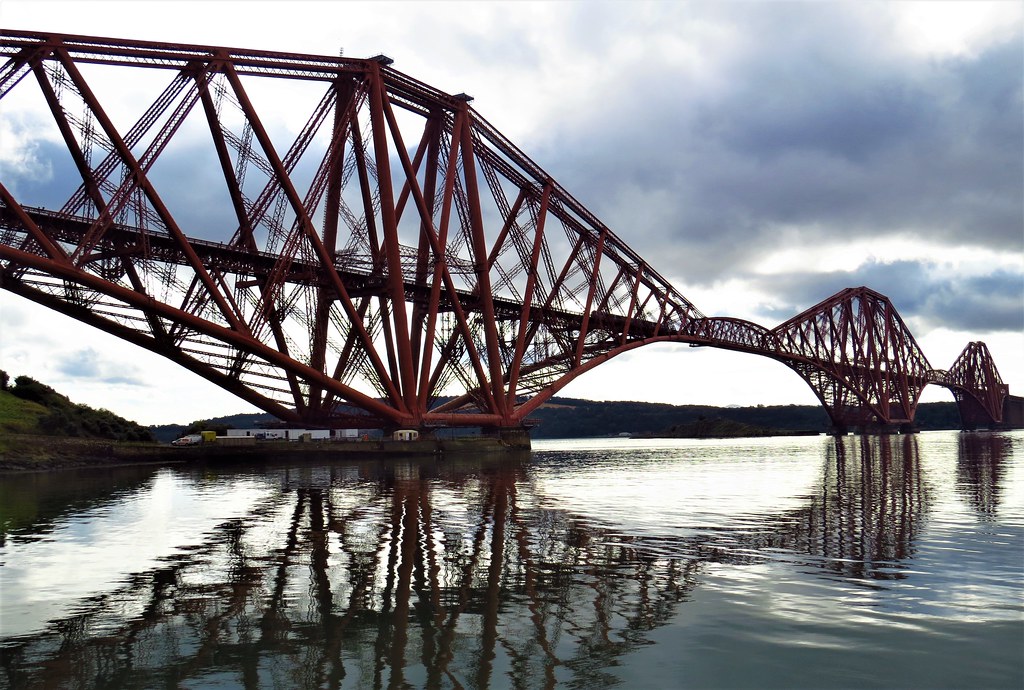By Maria Papagiannopoulou,
In the east of Scotland, 9 miles 14 km west of central, the Forth Bridge is a cantilever railway bridge across the Firth of Forth. Completed in 1890, it is considered a symbol of Scotland (having been voted Scotland’s greatest man-made wonder in 2016) and is a UNESCO World Heritage Site. It’s been built by British engineers, Sir John Fowler and Sir Benjamin Baker. The bridge was built in 1882, and the Duke of Rothesay, the future Edward VII, opened it on 4 March 1890. The bridge carries the Edinburgh–Aberdeen line across the Forth between the villages of South Queensferry and North Queensferry and has a total length of 8,094 feet (2,467 m). When it opened it had the longest single cantilever bridge span in the world, until 1919 when the Quebec Bridge in Canada was completed. Ferries had been used to travel across the Firth of Clyde before the construction of the bridge.
In 1806, a pair of tunnels, one for each direction, was proposed, and in 1818, James Anderson came up with a design for a three-span suspension bridge close to the site of the present one. Calling for approximately 2,500 tonnes (2,500 long tons; 2,800 short tons) of iron, Wilhelm Westhofen said of it “and this quantity [of iron] distributed over the length would have given it a very light and slender appearance, so light indeed that on a dull day it would hardly have been visible, and after a heavy gale probably no longer to be seen on a clear day either’’. For the railway age, Thomas Bouch designed for the Edinburgh and Northern Railway a roll-on/roll-off ferry between Granton and Burntisland that opened in 1850, which proved so successful that another was ordered for the Tay. Stephenson and Toner had been assigned to design the Forth Bridge at the end of 1863 by a joint project between the North British Railway and Edinburgh and Glasgow, which would be combined in 1865, but it was six months after that before Bouch took over their duties.

During the First World War, British sailors waited for their departure or return to their base at Rosyth by asking when they would pass under the bridge. The first German air attack on Britain in the Second World War took place over the Forth Bridge, six weeks into the war, on 16 October 1939. Although it was known as the “Forth Bridge” raid, the bridge was not the target, nor was it damaged. About two miles 3.2 km west of the bridge, the target of the attack was a cargo ship from the Rosyth naval base on the Forth. The Germans had been hoping to locate the biggest fleet ship in the Royal Navy, HMS Hood. Luftwaffe rules of engagement restricted action to targets on water and not in the dockyard. Although Repulse was in Rosyth, attacks were concentrated on cruisers Edinburgh and Southampton, the destroyer Jervis as well as aircraft carrier Furious.
Work started in 2002 to repaint the bridge fully for the first time in its history, in a £130 million contract awarded to Balfour Beatty. Up to 4,000 tonnes (3,900 long tons; 4,400 short tons) of scaffolding was on the bridge at any time, and computer modeling was used to analyze the additional wind load on the structure. To provide suitable conditions for the application of paint, the bridge has been packed in a climate-controlled membrane. Several simplifications are introduced in typical cantilever bridges such as the Forth Bridge. In this case, every pier has its two-armed cantilever, which is attached by a short girder to the next and thus so intertwined that no weight can be transferred out of one cantilever into another. The bridge, in essence, consists of separate sections which are essentially independent of each other.
References
- Forth bridge (2023) Wikipedia. Available here




